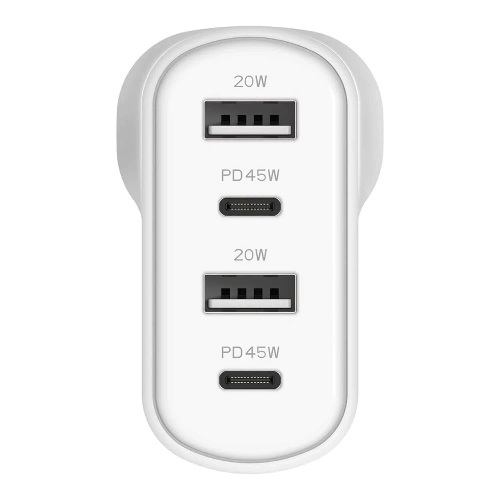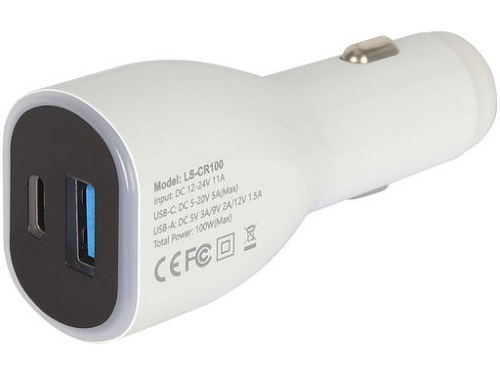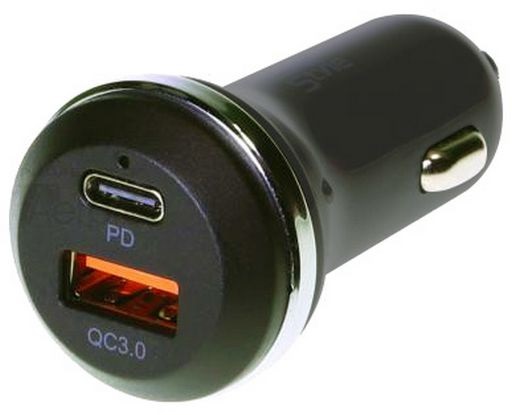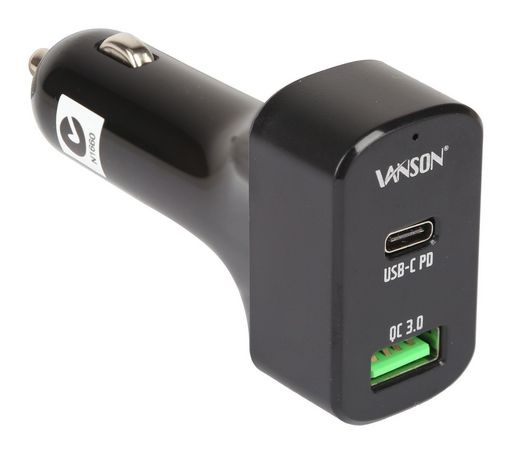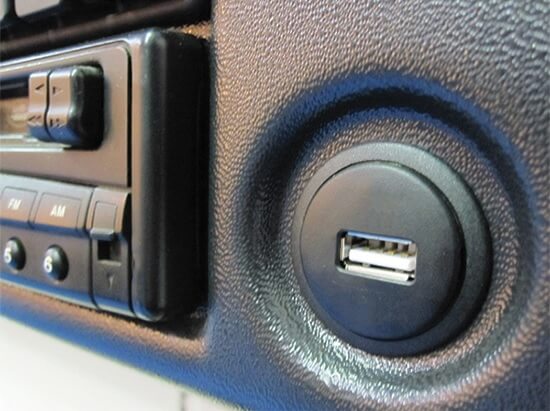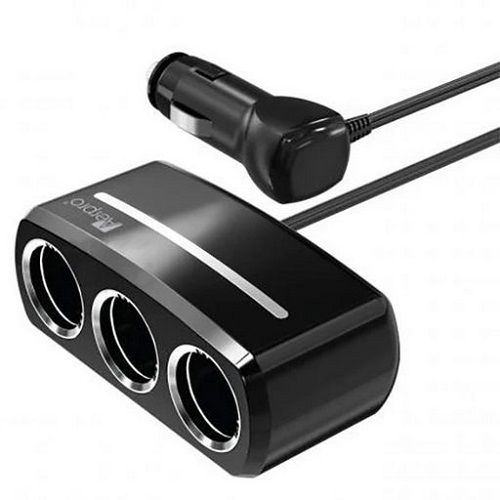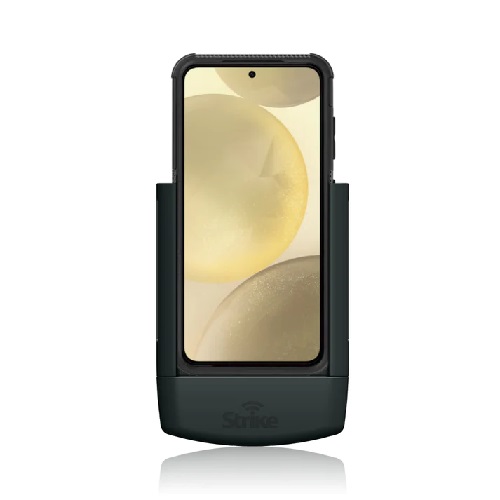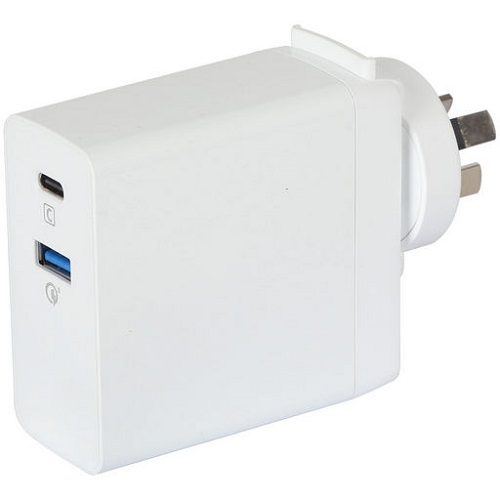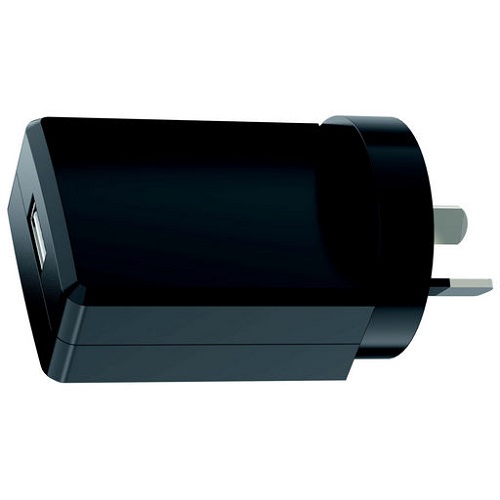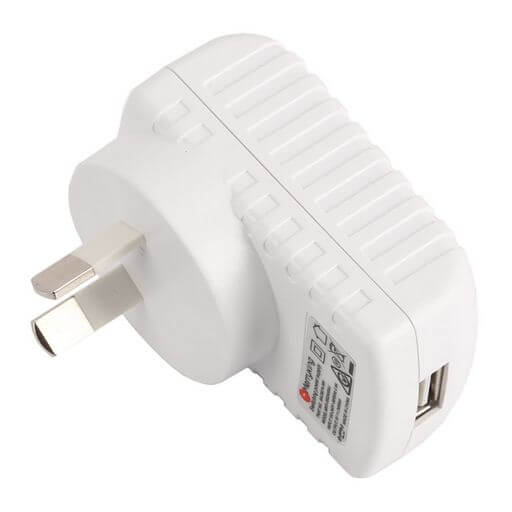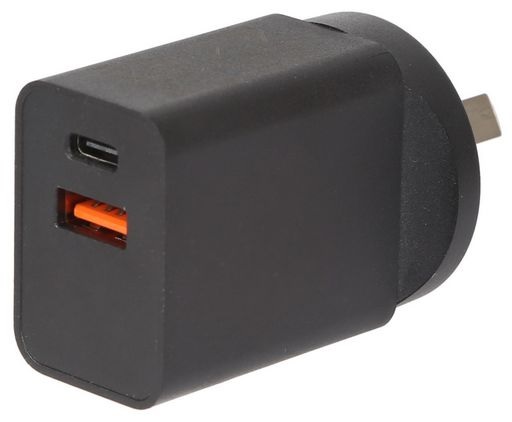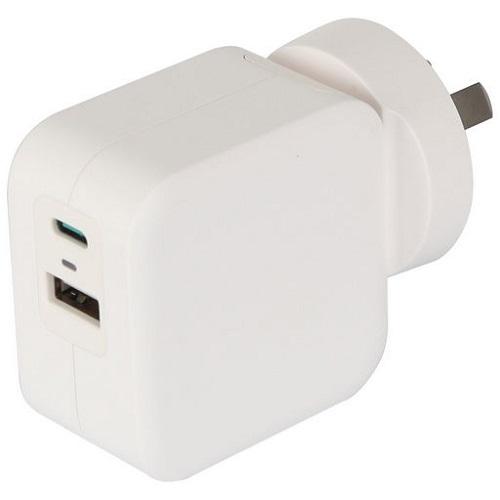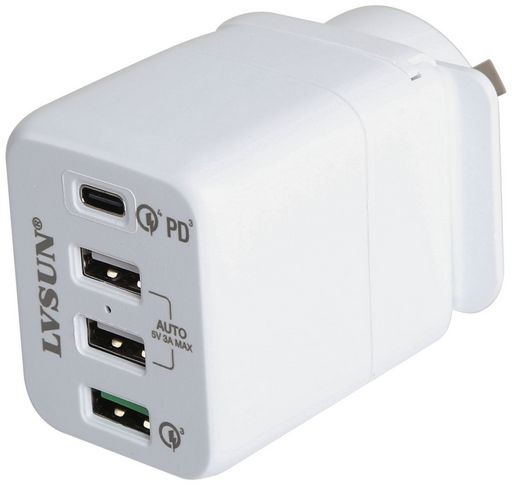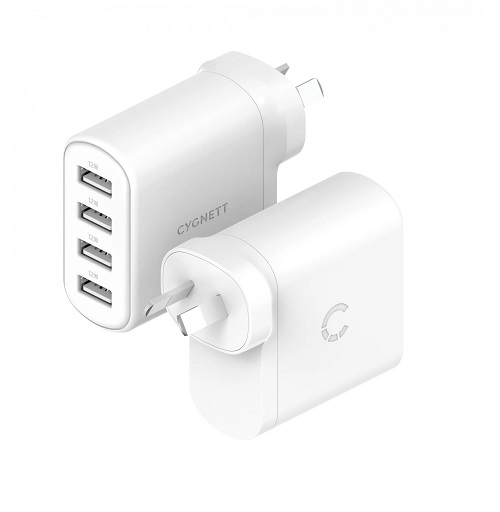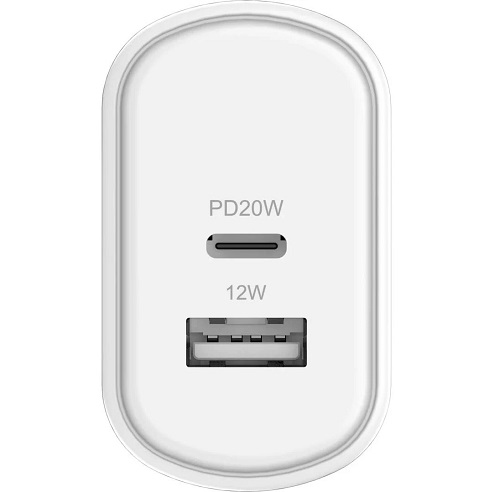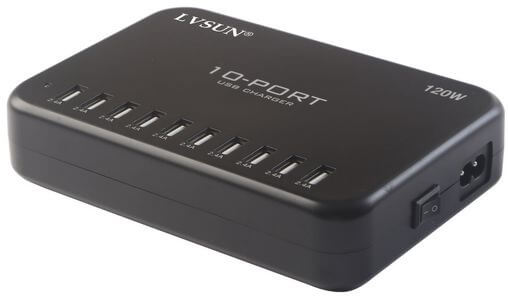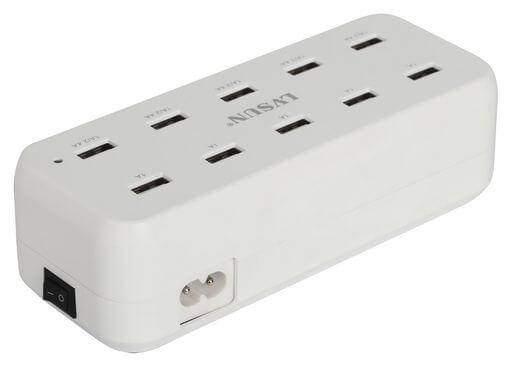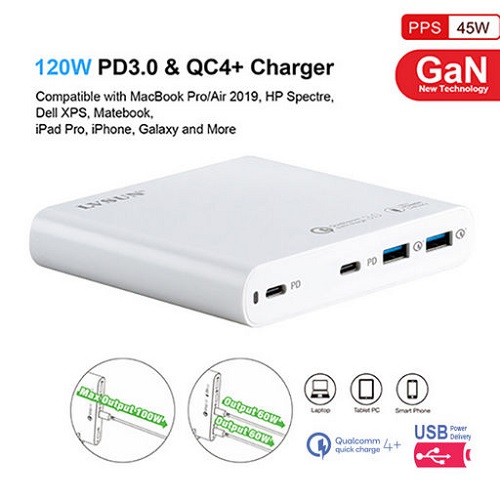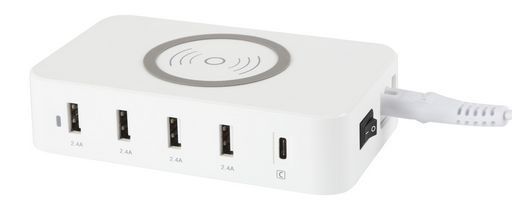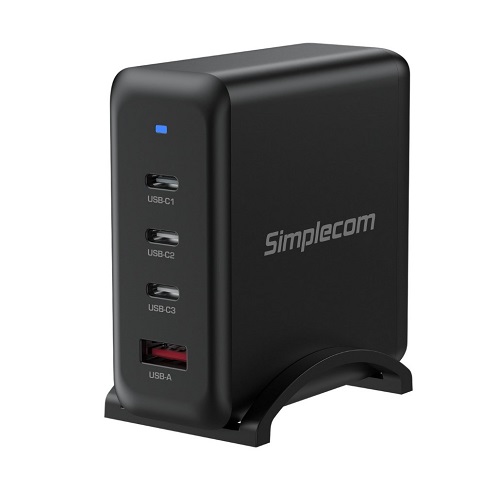USB Mains Chargers

Listed above is our range of USB chargers, USB charging hubs and car chargers. These chargers are designed to be used on Australian mains power and are fully approved and compliant with Australian Safety Standards. Every mobile tech device these days requires a USB wall charger, having an extra one around is a fantastic idea.
USB Wall Charger
Our USB phone chargers and USB mobile phone charging hubs have been designed for Australian conditions, meet all Australian safety standards and are ideal for people who have many devices that need to be charged be charged at once. Use your device's USB cable to charge your device.
Electricity across the world is not standard. You might have already gathered that by noting that electrical plugs in one part of the world look a darn sight different to the plugs in another part.
Not only are the plugs that they use in different parts of the world not the same, but the voltage (V) and frequency (Hz) of the electricity varies, too.
'The what?', you say? That's voltage, and frequency. And not knowing what they are can cause your electrical appliances, such as phone chargers, laptop chargers, hairdryers, and toasters, to either not work, or in the worst case scenario, blow up!
USB Wall Chargers: Voltage in Australia
In Australia, our houses are supplied with mains power of 230V/240V, with a frequency of 50Hz. Compare this now with the US, which has as standard 120V and 60Hz, or an in-car cigarette lighter at 6-12V. As you can see, these do not match up.
Now, appliances are built to comply with a particular voltage - usually if appliances are built in Australia or for Australia, they will be just fine - built to 230V. Many appliances work across a range of voltages, for example, a range of 220-240V - but you need to check each device to see, especially if it was purchased in or for another region.
This same check applies to the frequency of the electricity - the Hz. If your appliance says it is 60Hz, and not 50-60Hz, plugging it into an Australian outlet could have dire consequences.
So, just what are Watts? And what are Amps? I'm confused!
Watts are a unit of electricity. They're the figure that you will find on your electricity bill - well, kilowatt hours (KWh), actually, where 1000 Watts = 1 Kilowatt. Amps, on the other hand, is how much power an appliance takes to run. So, the higher the amps for an appliance, the higher your electricity bill will be! You can use these equations to navigate and work out volts, amps, and watts.
V (Volts) x A (Amps) = W (Watts)
A (Amps) = W (Watts) / V (Volts)
V (Volts) = W (Watts) / A (Amps)
For example, in Australia a dishwasher might have 120A, meaning for every hour they chew through 27,600 watts of electricity (230V x 120A = 27,600W). A laptop might use 60A, and so it uses 13,800 watts, or 13.8KWh.
When you see the energy efficiency stickers on your appliances around the home, you can get some idea of how much power they draw from the system. If you bought a cheap clothes dryer which has just one star on the energy efficiency scale, then you're probably going to end up spending more on your electricity bill over the years than if you had have bought a more expensive clothes dryer with four and a half stars.
What Does This Mean About Things That We Plug In To The Wall? USB Wall Chargers
This can all be very confusing. If we buy an electrical device such as a USB charger, we expect to just be able to plug it in and it will work. This, however, can be not the case at all.
Let's say that you purchased an electrical device from overseas without realising all this business about the different electrical requirements. Let's say that the device is a new hairdryer. This hairdryer has 110V, as that's what is used in the region it was made. Plugging this hairdryer into the mains power, in Australia - that's 230V/240V, remember? - can draw four times the power it was designed for.
Four times the power? That can make devices run way beyond the intent they were designed for - either breaking them, or overheating them, which in turn can cause electrical fires. All because you didn't understand the difference between regions and voltage.
On the flip side, if you take your Aussie 240V hairdryer over the states, and try and plug it into the wall outlet there, where the mains is 120V, then you might only draw a quarter of the power necessary to have the device running optimally. Which means that you might have a very slow hairdryer that can't even dry your hair, or doesn't work at all.
What can we do to prevent probably caused by mismatched voltages?
Always buy appliances from trusted sources
Always purchase Australian region-specific appliances
Always use power converters when taking appliances overseas
Check appliances for voltages (usually labelled) before plugging them in to the mains supply
Immediately unplug any devices that are behaving strangely
How does this relate to USB chargers?
USB is a standard for connection. USB cords can be used either to transfer data, or to supply power as in the case of USB chargers. There are currently 5 specific different types of USB cords in existence - USB 1.0, USB 2.0, USB 3.0, USB 3.1 and USB-C. USB-C does not look the same as the others, and isn't covered in this guide.
USB 3.1 is the current standard (released in July of 2013) that devices will come with, older devices will have used USB 1.0 (released 1998) or USB 2.0 (released 2000), or USB 3.0 (released 2008).
USB Chargers: USB 1.0 & 2.0 vs USB 3.0 vs USB 3.1
If you look carefully at the end of a USB 1.0 or 2.0 cable (the male part that fits into a socket), you will see 4 little connector pins. The two pins in the middle are for data transfer, and the two pins on the outside are for supplying power. The outside pins carry 5V power. USB 3.0 & 3.1 male connectors have an extra 5 pins.
The female USB ports (the ones you plug the cable into) can be either data transfer only (tablets may have this), data transfer and USB charging (like on your laptop or PC), and charging only (the AC wall plugs). In USB 1.0 and 2.0 the charging ports offer 0.1A (aka 100mA) or 0.5A (aka 500mA) power to the device. In USB 3.0, the charging ports offers 1.5A. In USB 3.1, you can charge with either 1.5A or 3.0A.
Not all USB are made equal. You've likely noticed that sometimes, some USB chargers and ports work faster than others. This is because of the different standards used. For example, if you have a phone that came with a 1000mA AC USB mains charger, and you then use it with a 3000mA AC mains charger that you got with your tablet, it will just charge faster than if used with your original phone charger. However, if you have an older device (pre-2008), it might not work with a newer USB port, and you might have to get your hands on a USB 1.0 or USB 2.0 charger. This is due to something called the 'Battery Charging Specification' which is another thing entirely - and too much to get into for the purposes of this piece!
USB PD: USB Power Delivery
Another specification is 'USB Power Delivery', available with USB 3.0, 3.1 and USB-C, which can provide multiple different power specs. These are:
Profile 1: 5V x 2A = 10W
Profile 2: 12V x 1.5A = 18W
Profile 3: 12V x 3A = 36W
Profile 4: 12V x 3A = 60W
Profile 5: 20V x 5A = 100W
This now means that a Power Delivery (PD) capable laptop could be charged via a PD capable data cable and a PD capable USB mains charger, which is starting to happen and which also means the end of power bricks!
So what should I look for in a USB mains charger?
Here are the things which are important when buying a USB wall charger:
Australian Safety Standards Approved, Australian USB mains chargers. This includes electrical compliance standards like the RCM electrical safety mark, the A tick, and the CE mark.
Check the voltage (AC input) of the USB charger is within the correct range for the region
Look for a high amplitude to charge your devices faster
Look for surge protective properties so if your mains surges, it won't fry your devices
Choose a USB mains charger with multiple slots so you can charge many devices at one
Look for travel mains chargers with interchangeable plugs for the wall if you travel often
It makes sense and is much safer in the long run when you are charging your phone or smartphone that can be worth up to worth several thousand dollars to pay a few more dollars for an Australian safety standards certified charger.
Multiport USB Chargers: The Ultimate Convenience
Ease of Use
Multiport USB chargers have become a staple in today's digital age. With the increasing number of devices we use daily, a single-port charger is no longer sufficient. A multi-port USB charger provides a convenient solution, allowing you to charge multiple devices simultaneously. Whether it's a USB car charger, USB wall outlet, or a USB charging hub, these chargers cater to different needs and preferences.
Variety of Options
The market offers a range of multiport USB chargers, from compact dual USB chargers to larger 6 USB chargers with digital displays. Some chargers, like the dual USB C charger, are designed specifically for newer devices that use USB-C ports. Others, like the 65W charger, are designed for power-hungry devices that require faster charging. With so many options available, you're sure to find a multiport USB charger that fits your needs.
Multi Port USB Wall Charger Benefits
One of the primary benefits of multiport USB chargers is the ability to charge multiple devices at once. This eliminates the need to constantly swap devices in and out of a single-port charger, saving you time and hassle. Additionally, many multiport USB chargers are designed to be compact and portable, making them perfect for travel or everyday use. Some chargers, like the wall charger, can even be installed in place of a traditional outlet, providing a convenient and space-saving solution.
USB Multi Charger Power and Price
When it comes to power, multiport USB chargers can deliver a range of wattages, from 18W to 100W or more. The 65W charger, for example, is designed for devices that require faster charging. As for price, multiport USB chargers can range from under $40 to over $100, depending on the number of ports, power output, and features. Regardless of the price, a multiport USB charger is a worthwhile investment for anyone who needs to charge multiple devices regularly.
4 Port USB Chargers: A Convenient Solution
The Need for Multiple USB Ports
We are surrounded by devices that require USB power adapters to stay charged. With the increasing number of smartphones, tablets, and other gadgets, a single USB port is no longer sufficient. This is where 4 port USB chargers come into play, offering a convenient solution to charge multiple devices simultaneously.
Features and Benefits of 4 Port USB Chargers
A 4 port USB charger is essentially a multi-port USB charging hub that can be plugged into a wall outlet or used as a USB car charger. These chargers are designed to provide rapid charging speeds, making them ideal for busy lives. With a multi USB charger, you can charge your devices quickly and efficiently, without having to constantly swap out cables. Additionally, 4 port USB chargers often come with built-in safety features, such as overcharge protection, to ensure your devices are protected from damage. Whether you're at home, in the office, or on-the-go, a 4 port USB charger is a must-have accessory for anyone with multiple devices.
12W USB Charger Black

This black fast USB charger features switch-mode regulation, allowing it to efficiently charge your devices. It supports a wide range of input voltages, from 100-240VAC, and provides a reliable output of 5VDC at 2400mA via a convenient USB type A socket.
Black 12W USB Charger
This balck 12W USB mains charger is designed with switch-mode regulation, making it compatible with any device that charges via a USB type A socket. Whether you're at home or in the office, it's perfect for quickly charging your phone or tablet. The charger accommodates input voltages of 100-240V AC and outputs 5VDC at 2100mA via a USB type A socket.
12W USB Charger Black Important Note
This 12W USB Charger Black is for use within Australia
12W USB Charger White
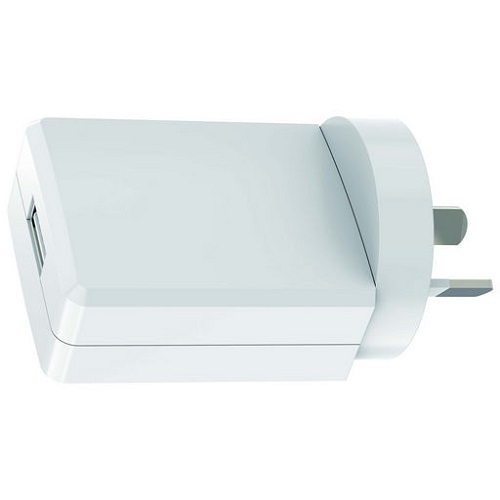
This white fast USB charger features switch-mode regulation, making it a reliable choice for your devices. It supports a wide range of input voltages, from 100-240VAC, and outputs up to 5VDC and 2400mA via a convenient USB type A socket.
White 12W USB Charger
This white 12W USB mains charger in white boasts switch-mode regulation, making it compatible with any device that charges via a USB type A socket. Whether you're at home or in the office, it's the perfect accessory for charging your phone or tablet. With an input voltage range of 100-240V AC, it outputs 5VDC at 2100 mA via a USB type A socket, ensuring safe and efficient charging.
12W USB Charger White Important Note
This 12W USB Charger is for use within Australia
4 Port USB Charger White
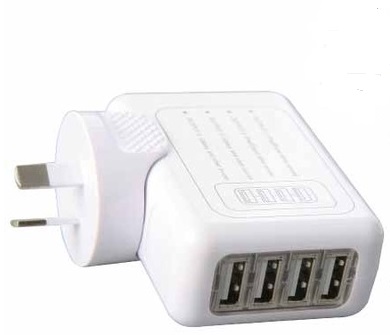
This 4-port USB charger allows you to connect and charge up to 4 USB devices directly to a mains socket, making it a convenient and space-saving solution. With automatic multi-voltage input of 100-240V, it can be used in various regions. The charger has a maximum output of 2.1A. It meets full Australian Standard Approvals, ensuring safety and reliability. Please note that a cable is not supplied with this product.
4 Port USB Charger White Important Note
This 4 port USB Charger is for use within Australia
5 Port USB Charger White
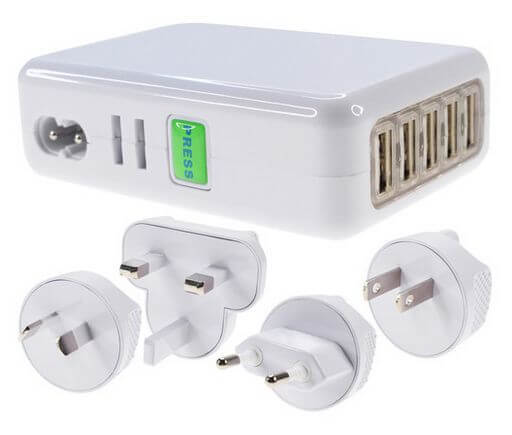
Compact 5 Port USB Charger with 7A Fast Charging And 4 Interchangeable Travel Adaptor Plugs
This compact travel charger is designed for international travelers, providing fast charging capabilities for up to 5 USB-powered devices simultaneously. With a total output of 7A, it can quickly charge multiple devices at once. The charger comes with 4 interchangeable travel adaptor plugs, compatible with AU/NZ, US/Japan, EU and UK standard sockets, making it a convenient and versatile travel accessory.
10 Port USB Charger: High Speed Charging Station

Charge up to 10 devices simultaneously with this high-speed charging station, featuring 10 independent USB outputs that deliver 2.4 Amps each. The intelligent recognition technology ensures fast and safe charging with auto-detecting current control.
High-Speed 10 Port USB Charging Station - 120W Key Features
- Ultra-high power output: 120W
- AC input: 100-240V with master power switch
- Multiple safety features: over current, over voltage, over temperature protection, and short circuit protection
- Compact design: 155x105x32mm
- Includes 1.8M power lead
10 Port USB Port Charger: High Speed Charging Station Black 60W

This charging station features 10 USB ports, with 5 ports capable of fast charging at 2.4Amp and 5 ports with standard charging at 1.0Amp.
High-Speed Charging Station with 10 USB Ports
The total output is 60W, making it ideal for charging multiple devices simultaneously. The compact design measures 155 x 60 x 40mm and comes with an AC power lead for easy connection.
10 Port USB Port Charger Important Note
This 10 port USB wall charger is for use within Australia
10 Port USB Port Charger: High Speed Charging Station White 60W

This high-speed charging station features 10 USB ports, with 5 fast charging ports capable of delivering 2.4Amps each and 5 regular charging ports providing 1.0 Amps each.
High-Speed Charging Station with 10 USB Ports
The total output is 60W, making it an ideal solution for simultaneously charging multiple devices. The charging station comes with an AC power lead and has a compact design, measuring 155 x 60 x 40mm.
10 Port USB Port Charger Important Note
This 10 port USB wall charger is for use within Australia
10 Port USB Charger: High Speed Intelligent Charging Station 120W

Charge up to 10 devices simultaneously with this high-power USB charging hub, featuring 10 independent USB outputs that can deliver 2.4A of fast charging power to each port. The hub intelligently recognizes devices with fast charging capabilities and auto-detects the required current for safe and efficient charging.
10-Port USB Charger: High-Speed Intelligent Charging Station (120W)
Four of the USB ports are equipped with the GI3520 USB3.0 chipset, allowing for data transfer speeds of up to 5Gbps. The hub accepts a wide range of AC input (100-240V) and features a master power switch for added convenience.
Safety features include over current, over voltage, over temperature protection, and short circuit protection to ensure safe and reliable charging. The compact hub measures 155x105x32mm, making it an ideal solution for charging multiple devices at once.
10 Port USB Charger: High Speed Intelligent Charging Station Important Note
This 10 port USB Charger is for use within Australia
36W 4 Port USB Car Charger With Quick Charge 3.0
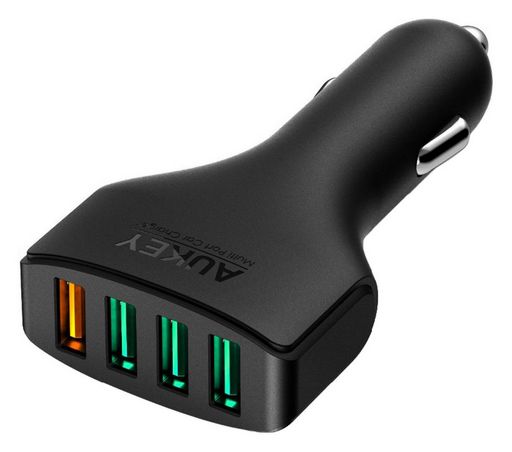
Stay charged on-the-go with this 4-port car charger, featuring one Quick Charge 3.0 USB port and three Hi-power USB charging ports.
36W 4-Port USB Car Charger with Quick Charge 3.0
The Quick Charge 3.0 port can charge compatible devices at a higher voltage, increasing charging speed.
Charger Output
- 3 x Hi-power USB ports: 5V, 2A (up to 18W)
- 1 x QC3.0 USB port: 5V @3A, 9V @2A, and 12V @1.5A (18W)
Safety features include over-current, overcharging, and overheating protection. Requires charging cable.
33.5W Two USB Port Car Charger With Quick Charge 3.0
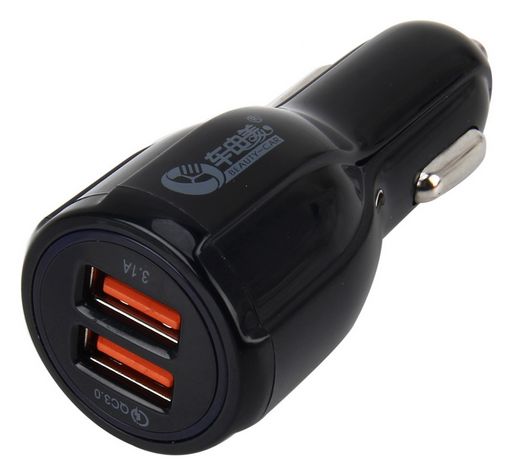
This 33.5W 2-port USB car charger allows you to charge multiple mobile devices simultaneously. It features one Quick Charge 3.0 USB port and one high-power USB charging port.
33.5W 2 USB Port Car Charger: Fast and Convenient Car Charging
The Quick Charge 3.0 USB port provides rapid charging for compatible devices at:
- 3.6V-6V @ 3.1A
- 6.5V-9V @ 2A
- 9V-12V @ 1.5A
The high-power USB port delivers: 5V 3.1A
Built with safety in mind, this car charger includes overload safety fuse protection. Please note that a charging cable is required for use.
The Evolution of USB Chargers: Faster, Smarter, and More Efficient
The era of bulky adapters and tangled cords is slowly fading away, thanks to the proliferation of smaller more compact USB chargers.
The Rise of USB Charging
The era of bulky adapters and tangled cords is slowly fading away, thanks to the proliferation of USB chargers. These compact devices have revolutionized the way we power our devices, making it easier to stay connected on-the-go. With the increasing demand for faster and more efficient charging, USB chargers have undergone significant transformations in recent years.
Types of USB Chargers
USB chargers come in various shapes, sizes, and configurations to cater to different needs and devices. From standard USB-A chargers to faster USB-C chargers, there's a charger for every device. Wall chargers, car chargers, and portable power banks are just a few examples of the diverse range of USB chargers available in the market.
USB Charging Speeds
Gone are the days of slow charging. Modern USB chargers support faster charging speeds, such as QuickCharge, VOOC and USB Power Delivery (PD). These technologies enable devices to charge rapidly, often reaching up to 80% capacity in under 30 minutes. USB-C chargers, in particular, have become popular for their ability to deliver higher power outputs, making them ideal for laptops and other power-hungry devices.
Smart USB Chargers
The latest generation of USB chargers boasts advanced features, such as smart charging and power management. These intelligent chargers can detect the type of device connected and adjust the power output accordingly, ensuring safe and efficient charging. Some high-end USB chargers even come with built-in circuit protection, overcharge protection and short-circuit protection to prevent damage to devices.
The Future of USB Charging
As technology continues to advance, we can expect USB chargers to become even faster, more efficient, and more convenient. The adoption of wireless charging and USB-C as the new standard for charging is likely to drive innovation in the industry. With the increasing focus on sustainability, we may also see a rise in eco-friendly USB chargers made from recycled materials.
USB Chargers Summary
USB chargers have come a long way, offering faster, smarter, and more efficient charging solutions for our devices. As the demand for reliable and convenient charging continues to grow, manufacturers are responding with innovative products that cater to diverse needs. Whether you're looking for a compact wall charger or a high-capacity power bank, there's a USB charger out there to keep your devices powered up and ready to go.
45W 2 Port USB Car Charger With Quick Charge 3.0
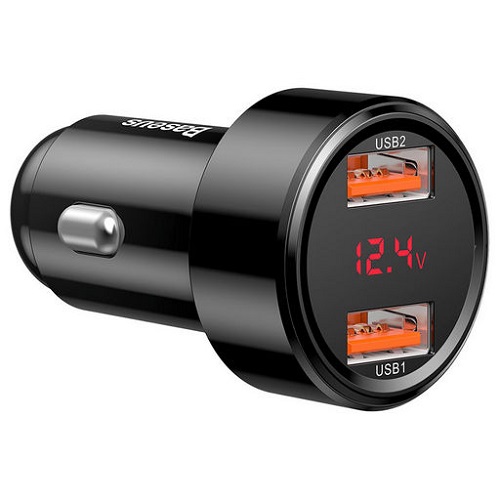
This car charger features dual USB ports with Quick Charge 3.0, allowing for faster charging of compatible devices.
45W 2 USB Port Charger With Quick Charge 3.0: Fast and Convenient Car Charging
This charger provides a maximum output of 45W, with two QC3.0 USB ports that can charge devices at higher voltages.
45W 2 Port USB Car Charger Key Features
- 2x QC3.0 USB ports
- QC3 Output Power: 2x 4.5V @5A, 5V @4.5A, 9V @3A, 12V @3A, and 20V @2.25A
- Requires charging cable
- Multiple safety features, including: Overheating protection, Short circuit protection, Over discharge protection, Overvoltage protection, Overcurrent protection
45W 2 Port USB Car Charger With Quick Charge 3.0 Important Note
Note: 20V output is only supported if the input voltage is at 24V.
USB Chargers: Fast, Efficient And Convenient
A USB charger is a device that supplies electric power to a wide range of devices, including smartphones, tablets, laptops, and other portable electronics.
What is a USB Charger?
USB chargers have become an essential accessory in today's digital age, providing a convenient and efficient way to charge devices on-the-go. With the proliferation of USB-enabled devices, USB chargers have become a ubiquitous feature in homes, offices, and public spaces.
What Are the Types of USB Chargers?
There are several types of USB chargers available in the market, catering to different needs and devices. Some of the most common types of USB chargers include:
- Standard USB Chargers: These are the most common type of USB chargers, providing a standard 5V output and 1A current. They are suitable for charging small devices such as smartphones and tablets.
- Fast USB Chargers: These chargers provide a higher current output, typically 2A or 3A, allowing for faster charging of devices. They are ideal for charging larger devices such as laptops and power-hungry smartphones.
- Quick Charge USB Chargers: These chargers use advanced technology to charge devices up to 75% faster than standard USB chargers. They are designed for devices that support Quick Charge technology.
- Wireless USB Chargers: These chargers use wireless charging technology to charge devices without the need for cables.
Features of USB Chargers
USB chargers offer several benefits, including:
- Convenience: USB chargers are easy to use and provide a convenient way to charge devices without the need for multiple cables and adapters.
- Efficiency: USB chargers are designed to provide efficient charging, minimizing energy waste and reducing charging times.
- Portability: USB chargers are compact and lightweight, making them easy to carry around.
- Universal Compatibility: USB chargers are compatible with a wide range of devices, making them a versatile accessory for anyone with multiple devices.
Choosing the Right USB Charger
When choosing a USB charger, consider the following factors:
- Output Power: Choose a charger with sufficient output power to charge your device. A higher output power charger may be required for larger devices or for charging multiple devices simultaneously.
- Compatibility: Ensure that the charger is compatible with your device. Check the manufacturer's specifications to confirm compatibility.
- Safety Features: Look for chargers with built-in safety features, such as overcharge protection and short-circuit protection.
- Brand Reputation: Choose a reputable brand that offers high-quality chargers with reliable performance.
USB Charging And The Future
As technology continues to evolve, we can expect to see further advancements in USB charging technology. Some of the emerging trends in USB charging include:
- USB-C Chargers: USB-C chargers are becoming increasingly popular, offering faster charging speeds and higher output power.
- Wireless Charging: Wireless charging technology is becoming more widespread, offering a convenient and cable-free charging experience.
- Solar-Powered Chargers: Solar-powered chargers are becoming more popular, offering a sustainable and eco-friendly way to charge devices.
USB Charging Innovations
USB chargers have revolutionized the way we charge our devices, offering a convenient, efficient, and portable solution for our charging needs. With the continuous evolution of USB charging technology, we can expect to see even more innovative and efficient charging solutions in the future.
<
>
